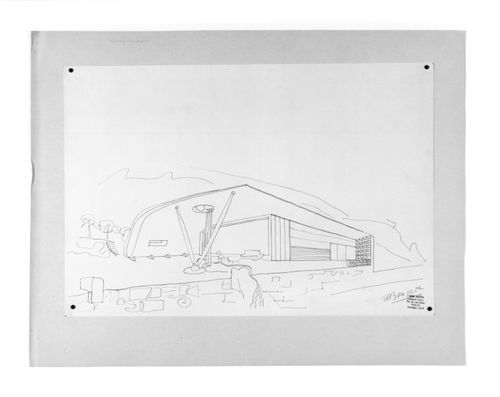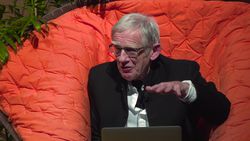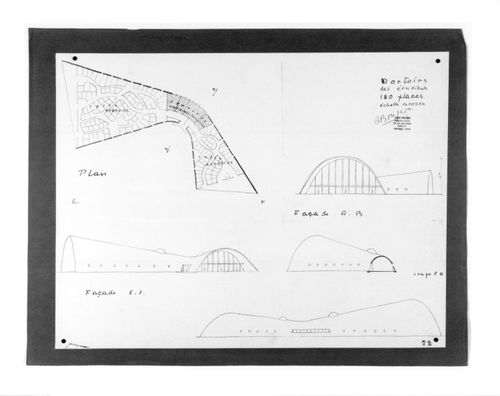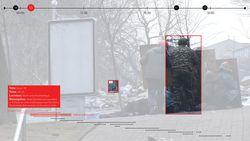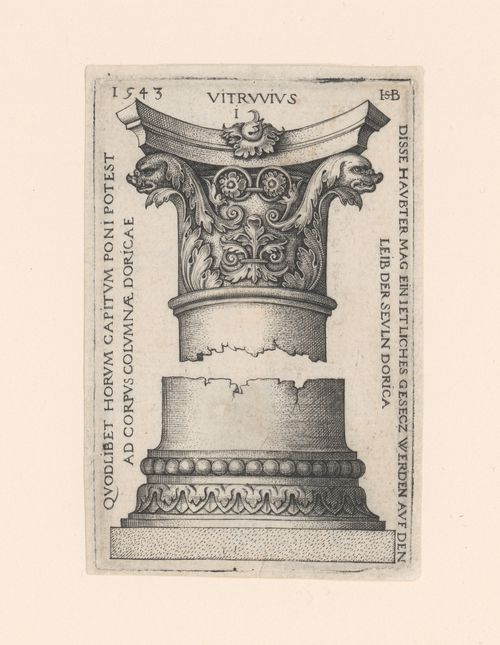DR1996:0010
Description:
- Two groups of four pastel drawings were originally produced in connection with the Village Polychrome project. The architect André Bruyère had retained one group, while the other was given to the patron and client, Francisco de Assis Chateaubriand Bandeira de Melo, who then donated it to the Sao Paolo Museum of Modern Art. Bruyère subsequently gave one of the four drawings in his group to a friend. The three remaining drawings from Bruyère's group are in the CCA Prints and Drawings collection (DR1996:0001 - DR1996:0003) ("Projet de Village Polychrome, Biot, France").
architecture
1952-1953
Perspective for a guest villa showing the terrace and the principal and lateral façades, Village Polychrome, near Biot, France
Actions:
DR1996:0010
Description:
- Two groups of four pastel drawings were originally produced in connection with the Village Polychrome project. The architect André Bruyère had retained one group, while the other was given to the patron and client, Francisco de Assis Chateaubriand Bandeira de Melo, who then donated it to the Sao Paolo Museum of Modern Art. Bruyère subsequently gave one of the four drawings in his group to a friend. The three remaining drawings from Bruyère's group are in the CCA Prints and Drawings collection (DR1996:0001 - DR1996:0003) ("Projet de Village Polychrome, Biot, France").
architecture
Individuals act as their own historians, suppressing some stories and emphasizing others. But at the scale of nations and cultures, and especially in this age of ubiquitous digital memory, it has become more difficult to forget. Building on questions about history and its uses, raised by exhibitions like Educating Architects: Four Courses by Kenneth Frampton and Besides,(...)
Craig Hodgetts
29 March 2018
Come and Forget the Grid, with Craig Hodgetts
Actions:
Description:
Individuals act as their own historians, suppressing some stories and emphasizing others. But at the scale of nations and cultures, and especially in this age of ubiquitous digital memory, it has become more difficult to forget. Building on questions about history and its uses, raised by exhibitions like Educating Architects: Four Courses by Kenneth Frampton and Besides,(...)
Craig Hodgetts
Project
AP178.S1.1984.PR03
Description:
This project series documents the Duas habitações e duas loja in Schilderswijk, The Hague, The Netherlands. While the records were held in the office’s archives this project was assigned the number 31/80. The office assigned the date 1985 to this project. This project was part of the urban renewal program in Schilderswijk for which Siza designed the urban plan for Deelgebied Zone 5 Schilderswijk-West, the Punt en Komma social housing, Plano de Doedijnstraat, and Van der Vennerpark. The project consisted of two houses, two retail/office spaces, and a parking garage situated on Van der Vennestraat. One house was made with red brick, while the other was given a white exterior. The project was realised with project architect Carlos Castenheira in cooperation with Architektengroep Mecanoo. This project was designed in connection with the Van der Vennepark (project series AP178.S1.1985.PR01 in this fonds). The project series contains sketches, studies, plans, elevations and details. Textual documentation includes a letter from Adri Duivesteijn, The Hague alderman responsible for the urban renewal program, letters from Architektengroep Mecanoo (engeneering firm), notes from meetings on construction, and a letter from Castanheira. Documentation regarding the Van der Vennerpark (file AP178.S1.1985.PR01.001 in this fonds) also contains information related to the housing and shopping complex. Also included are photographs of the model, as well as slides of the model, drawings, and the built project. Note that photographs of the built project can also be found among photographic materials for Punt en Komma (file AP178.S1.1984.PR02.SS1.015 in this fonds).
1985-1988
Duas habitações e duas lojas [Housing and shopping complex, Schilderswijk], The Hague, The Netherlands (1985-1988)
Actions:
AP178.S1.1984.PR03
Description:
This project series documents the Duas habitações e duas loja in Schilderswijk, The Hague, The Netherlands. While the records were held in the office’s archives this project was assigned the number 31/80. The office assigned the date 1985 to this project. This project was part of the urban renewal program in Schilderswijk for which Siza designed the urban plan for Deelgebied Zone 5 Schilderswijk-West, the Punt en Komma social housing, Plano de Doedijnstraat, and Van der Vennerpark. The project consisted of two houses, two retail/office spaces, and a parking garage situated on Van der Vennestraat. One house was made with red brick, while the other was given a white exterior. The project was realised with project architect Carlos Castenheira in cooperation with Architektengroep Mecanoo. This project was designed in connection with the Van der Vennepark (project series AP178.S1.1985.PR01 in this fonds). The project series contains sketches, studies, plans, elevations and details. Textual documentation includes a letter from Adri Duivesteijn, The Hague alderman responsible for the urban renewal program, letters from Architektengroep Mecanoo (engeneering firm), notes from meetings on construction, and a letter from Castanheira. Documentation regarding the Van der Vennerpark (file AP178.S1.1985.PR01.001 in this fonds) also contains information related to the housing and shopping complex. Also included are photographs of the model, as well as slides of the model, drawings, and the built project. Note that photographs of the built project can also be found among photographic materials for Punt en Komma (file AP178.S1.1984.PR02.SS1.015 in this fonds).
Project
1985-1988
photographs
PH1986:0777:001-096
Description:
First edition of an album containing 96 photographs of sculptural and ornamental details (mostly fragments) of the models made in stone, wood, bronze, iron cast and carton-pierre by sculptor Emile Knecht for the Palais des Tuileries and the Louvre, Paris, under the direction of Mr. H. Lefuel, architect of the Emperor. The photographs show details of ornamentation for the Palais des Tuileries: for the staircase of Sa Majesté l'Impératrice; the door to her apartments; the ceiling of the vestibule; the apartments of Sa Majesté le Prince Impérial; the Salle des Gardes; the Salon de famille and the dining room of the Minister of State; the Pavillon de la Bibliothèque of the Louvre; the door to the Pavillon Richelieu of the Louvre; the chimney for the Bibliothèque; the Daru, Denon, Nollieu and Lesdiguière Pavilions of the Louvre; the Ancienne Chapelle of the Louvre; the door of the Museum; the old Louvre and the Hôtel de Monsieur Fould. Two lithographs from "Les artistes industriels" show a table and a gun; other photographs show a barometer and thermometer on a sculpted panel, a sculpted Madonna and Child in a niche, a sculpted table and a small armoire by Tahan photographed by Franck.
architecture, ornament, sculpture
1853-1860
Le Palais des Tuileries and the Louvre, views of sculptural details cast for the buildings, Paris, France
Actions:
PH1986:0777:001-096
Description:
First edition of an album containing 96 photographs of sculptural and ornamental details (mostly fragments) of the models made in stone, wood, bronze, iron cast and carton-pierre by sculptor Emile Knecht for the Palais des Tuileries and the Louvre, Paris, under the direction of Mr. H. Lefuel, architect of the Emperor. The photographs show details of ornamentation for the Palais des Tuileries: for the staircase of Sa Majesté l'Impératrice; the door to her apartments; the ceiling of the vestibule; the apartments of Sa Majesté le Prince Impérial; the Salle des Gardes; the Salon de famille and the dining room of the Minister of State; the Pavillon de la Bibliothèque of the Louvre; the door to the Pavillon Richelieu of the Louvre; the chimney for the Bibliothèque; the Daru, Denon, Nollieu and Lesdiguière Pavilions of the Louvre; the Ancienne Chapelle of the Louvre; the door of the Museum; the old Louvre and the Hôtel de Monsieur Fould. Two lithographs from "Les artistes industriels" show a table and a gun; other photographs show a barometer and thermometer on a sculpted panel, a sculpted Madonna and Child in a niche, a sculpted table and a small armoire by Tahan photographed by Franck.
photographs
1853-1860
architecture, ornament, sculpture
Project
CI005.S1.1956.PR1
Description:
The Netherlands Congress Centre owed its genesis to architect-town planner, W.M. Dudok, who suggested creating a cultural centre for international conferences. In 1956 an ad hoc committee proposed the creation of a congress centre and invited Oud, in 1956, to design a centre that would incorporate a 3000 seat conference hall as well as other rooms for functions and events. Oud created a detailed design in 1958 that featured a seventeen-storey tower with hotel rooms. Oud amended his plans somewhat, creating an oval-shaped conference hall. In 1960 Oud further revised his design to reduce the main hall seating to 1500, and also designated it for use of theatrical events. Oud died in 1963 before the completion of construction. He was replaced by his son, Hans Oud, until the congress centre was erected in 1969 (Taverne et al. 2001, 544-546). Project series includes plans for the Congress Hall Complex.
1956-1963
Netherlands Congress Centre Complex, The Hague, Netherlands (1956-1963)
Actions:
CI005.S1.1956.PR1
Description:
The Netherlands Congress Centre owed its genesis to architect-town planner, W.M. Dudok, who suggested creating a cultural centre for international conferences. In 1956 an ad hoc committee proposed the creation of a congress centre and invited Oud, in 1956, to design a centre that would incorporate a 3000 seat conference hall as well as other rooms for functions and events. Oud created a detailed design in 1958 that featured a seventeen-storey tower with hotel rooms. Oud amended his plans somewhat, creating an oval-shaped conference hall. In 1960 Oud further revised his design to reduce the main hall seating to 1500, and also designated it for use of theatrical events. Oud died in 1963 before the completion of construction. He was replaced by his son, Hans Oud, until the congress centre was erected in 1969 (Taverne et al. 2001, 544-546). Project series includes plans for the Congress Hall Complex.
project
1956-1963
Project
AP056.S1.1991.PR03
Description:
This project series documents planning for the Westnor Development Project, later called Wittington Place, in North York, Ontario from 1991-1997. The office identified the project number as 9106. This project consisted of a competition entry to develop the area above Highway 401 next to Yonge Street. The large plot of land would be a mix of residential, retail, hotel, office and outdoor spaces. The competition also called for the creation of a sports arena, Canada Coliseum, to be used for professional basketball and hockey. This entry was proposed by New York based firm Ehrenkrantz Eckstut and Whitelaw Architects, working with KPMB, among others.[1] The development was to be carried out in multiple phases, divided by city blocks. The drawings present different schemes for this development, most of which include a large park at its centre. This project was never built. The project is recorded through drawings and a site plan painting dating from 1991-1997. The large part of these drawings are originals and include sketches, model drawings, site plans and surveys, elevations, sections, perspectives and axonometric drawings. These drawings focus primarily on the development of the area as a whole and less on individual buildings. [1] Mark Osbaldeston, Unbuilt Toronto 2: More of the City That Might Have Been (Toronto: Dundurn Press, 2001), 160.
1991-1997
The Westnor Development Project, North York, Ontario (1991-1997)
Actions:
AP056.S1.1991.PR03
Description:
This project series documents planning for the Westnor Development Project, later called Wittington Place, in North York, Ontario from 1991-1997. The office identified the project number as 9106. This project consisted of a competition entry to develop the area above Highway 401 next to Yonge Street. The large plot of land would be a mix of residential, retail, hotel, office and outdoor spaces. The competition also called for the creation of a sports arena, Canada Coliseum, to be used for professional basketball and hockey. This entry was proposed by New York based firm Ehrenkrantz Eckstut and Whitelaw Architects, working with KPMB, among others.[1] The development was to be carried out in multiple phases, divided by city blocks. The drawings present different schemes for this development, most of which include a large park at its centre. This project was never built. The project is recorded through drawings and a site plan painting dating from 1991-1997. The large part of these drawings are originals and include sketches, model drawings, site plans and surveys, elevations, sections, perspectives and axonometric drawings. These drawings focus primarily on the development of the area as a whole and less on individual buildings. [1] Mark Osbaldeston, Unbuilt Toronto 2: More of the City That Might Have Been (Toronto: Dundurn Press, 2001), 160.
Project
1991-1997
DR1996:0008
Description:
- Two groups of four pastel drawings were originally produced in connection with the Village Polychrome project. The architect André Bruyère had retained one group, while the other was given to the patron and client, Francisco de Assis Chateaubriand Bandeira de Melo, who then donated it to the Sao Paolo Museum of Modern Art. Bruyère subsequently gave one of the four drawings in his group to a friend. The three remaining drawings from Bruyère's group are in the CCA Prints and Drawings collection (DR1996:0001 - DR1996:0003) ("Projet de Village Polychrome, Biot, France").
architecture
1952-1953
Plan, elevations and a section for the dormitory, Village Polychrome, near Biot, France
Actions:
DR1996:0008
Description:
- Two groups of four pastel drawings were originally produced in connection with the Village Polychrome project. The architect André Bruyère had retained one group, while the other was given to the patron and client, Francisco de Assis Chateaubriand Bandeira de Melo, who then donated it to the Sao Paolo Museum of Modern Art. Bruyère subsequently gave one of the four drawings in his group to a friend. The three remaining drawings from Bruyère's group are in the CCA Prints and Drawings collection (DR1996:0001 - DR1996:0003) ("Projet de Village Polychrome, Biot, France").
architecture
The expanded role: SITU
Bradley Samuels presents recent SITU Research work and the role that research plays within the larger practice of SITU as a whole. A series of case studies will be presented which explore an expanded role for architectural and spatial practice across a range of fields—from human rights and public policy to earth science and workspace design. SITU Research’s past work(...)
Paul-Desmarais Theatre
14 January 2016
The expanded role: SITU
Actions:
Description:
Bradley Samuels presents recent SITU Research work and the role that research plays within the larger practice of SITU as a whole. A series of case studies will be presented which explore an expanded role for architectural and spatial practice across a range of fields—from human rights and public policy to earth science and workspace design. SITU Research’s past work(...)
Paul-Desmarais Theatre
DR1987:0342
Description:
- This engraving depicts a design for an order of architecture showing the capital and the base. Although the inscriptions refer to "DORICA[E]", this is not one of the traditional orders of architecture: the acanthus leaves on the capital suggest a Corinthian model while other details, such as the dolphin heads, suggest a more personal interpretation. - This print is one of a set of four prints of capitals and bases which were engraved by Hans Sebald Beham. Patricia Condon suggests that these prints were made for a general audience rather than for architects ('Ornament and Architecture', 29). Three of the prints in the CCA collection are from the collection of the Ducs d'Arenburg, while the provenance of this print is unknown.
architecture
1543
Design for the capital and base of a column
Actions:
DR1987:0342
Description:
- This engraving depicts a design for an order of architecture showing the capital and the base. Although the inscriptions refer to "DORICA[E]", this is not one of the traditional orders of architecture: the acanthus leaves on the capital suggest a Corinthian model while other details, such as the dolphin heads, suggest a more personal interpretation. - This print is one of a set of four prints of capitals and bases which were engraved by Hans Sebald Beham. Patricia Condon suggests that these prints were made for a general audience rather than for architects ('Ornament and Architecture', 29). Three of the prints in the CCA collection are from the collection of the Ducs d'Arenburg, while the provenance of this print is unknown.
architecture
DR1974:0002:021:001-033
Description:
- This album contains studies by Charles Rohault de Fleury of the five classical orders. The majority of the drawings are from his student years at the Ecole des Beaux-Arts (1822-1825). Others are from his student years at the Ecole Polytechnique (1820-1822), or drawings executed while he was a practicing architect (after 1825). Although the drawings are not physically organized into categories within the album, they can be divided into three groups according to their architectural sources: paradigmatic examples taken from named monuments of Greek and Roman architecture, examples taken from unnamed architectural monuments or treatises, and examples after 16th century Italian and French interpretors of the classical tradition, such as Palladio, Serlio, Vignola and Delorme. The only exception to these categories is the drawing of the "soubassement" for the pavilions of the Louvre (DR1974:0002:021:032 R/V). Most of the drawings focus on the proportions of the orders, their disposition within the portico in terms of intercolumnar spacing and number of columns, and the proper moulding and ornamentation particular to each order. This album also contains four etchings of similar subject matter by Gaitte, Stévigny, Piranesi, and an unknown early 19th century etcher.
drawings executed between 1818-1832, prints executed 1776 ?-1832
Album of mostly student drawings of the Orders
Actions:
DR1974:0002:021:001-033
Description:
- This album contains studies by Charles Rohault de Fleury of the five classical orders. The majority of the drawings are from his student years at the Ecole des Beaux-Arts (1822-1825). Others are from his student years at the Ecole Polytechnique (1820-1822), or drawings executed while he was a practicing architect (after 1825). Although the drawings are not physically organized into categories within the album, they can be divided into three groups according to their architectural sources: paradigmatic examples taken from named monuments of Greek and Roman architecture, examples taken from unnamed architectural monuments or treatises, and examples after 16th century Italian and French interpretors of the classical tradition, such as Palladio, Serlio, Vignola and Delorme. The only exception to these categories is the drawing of the "soubassement" for the pavilions of the Louvre (DR1974:0002:021:032 R/V). Most of the drawings focus on the proportions of the orders, their disposition within the portico in terms of intercolumnar spacing and number of columns, and the proper moulding and ornamentation particular to each order. This album also contains four etchings of similar subject matter by Gaitte, Stévigny, Piranesi, and an unknown early 19th century etcher.
